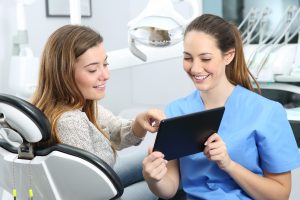
Wouldn’t it be great if you never had to deal with a denied claim again? One way to help prevent these hassles is by having more diagnostic information from the beginning! The quantitative results that you receive in a salivary diagnostics report gives you a measurable overview of a patient’s bacterial profile as well as risk level—both of which provide crucial evidence for your best chance at insurance coverage. (You’ll also have a great baseline from which you can assess the efficacy of treatment.)
Likewise, patients are often hesitant to move forward with anything outside of the “norm”—especially if they have to pay for it out-of-pocket. So how do you help patients understand the benefits of having diagnostic information like this? One way to discuss your patient’s periodontal conditions and introduce new technology is to say something like:
“Mrs. X, for ____years, we have been trying to control your periodontal disease; however, your body is not responding. We have seen (persistent bleeding/infection) and this is not getting any better. What I see today is….
“What I would recommend is that we do a test to determine what your risk factors are and what bacteria are present so that we can treat your infection more specifically. This is like a cholesterol test—it takes the guesswork out of your treatment.”
By incorporating salivary diagnostics in your practice, you will be encouraging patients to follow through with treatment by helping them see what ordinarily cannot be seen. You will help them achieve improved treatment outcomes and better oral and systemic health. You will be more confident in your diagnosis and treatment recommendations, and you will increase the oral-systemic awareness in your community. So, what are you waiting for?
If you want to educate yourself and your team about the importance of pathogen testing and the latest research surrounding the oral-systemic connection, consider attending the 2017 American Academy for Oral Systemic Health Scientific Session—September 15-17, 2017, in Salt Lake City.
For more information on how to become an OralDNA Provider – scan HERE: 
- Reduce Dental Benefit Hassles and Help Your Patients Say “YES” - July 3, 2020
- 3 Surefire Ways To Make 2019 Your BEST Year Ever - April 26, 2019
- “Seeing” What Can’t Be “Seen” - July 7, 2017
